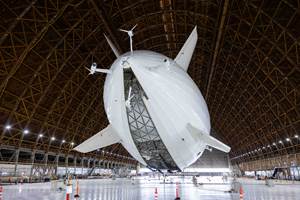Carbon fiber composite liner-less pressure tank handles cryogenic temps
Cimarron Composites has made a leap forward in all-composite cryogenic tank development.
A few days ago, I was contacted by Tom DeLay, founder of Cimarron Composites (Huntsville, AL, US), because I had written about DeLay and work he was involved with at NASA in the area of high-performance composite pressure vessels. That 2005 article (here’s the link: https://www.compositesworld.com/articles/an-update-on-composite-tanks-for-cryogens) was a review of sorts, describing the state of composite pressure vessels for space applications, including storage of cryogens like liquid oxygen.
Unbeknownst to me, DeLay, in 2008, started Cimarron Composites to focus on composite pressure vessels and improving their performance in cryogenic applications. At the time of my article in 2005, tankage for super-cold liquid fuels — liquid hydrogen, liquid oxygen (LOX) and others — was still the purview of metals, due to the potential for microcracking in traditional carbon/epoxy composite laminates at cryogenic temperatures. Microcracks can occur in any laminate because of the difference between the axial and transverse coefficients of thermal expansion (CTE) in each ply, as the laminate cools after cure, and as temperature is lowered to cryogenic levels. Even at moderate pressure, the composite's exposure to temperature extremes and repeated fill-and-drain cycles can exacerbate cracking and can lead to permeation leak paths, easily traversed by small hydrogen and oxygen molecules. The issue isn't helped by the fact that most legacy thermoset systems lose strain capacity and become brittle at cryogenic temperatures.
DeLay has been working on this issue, at Cimarron Composites. His company has, he says, made a leap forward in all-composite cryogenic tank development. They have achieved a 15,000 micro-strain performance with a carbon fiber-reinforced composite tank, while in a pressurized liquid nitrogen environment. Successful operation at such a high strain level allows the liner-less composite tank structure, made with a unique mixture of textiles and continuous wound fibers, to be much thinner than what was previously needed in these types of tanks, without the cost and mass of the liner. According to DeLay, earlier composite tank programs were limited to 3,000 micro-strain due to materials and processing limitations and this resulted in extra mass. Cimarron’s new tank technology uses a unique material system that performs well at extremely low temperatures without developing the microcracks that create leak paths for fluids like liquid oxygen, liquid hydrogen or liquid methane.
The company’s 44-inch diameter test article is representative of the size required for the development of small rocket concepts used for nano-satellite deliveries. The Cimarron technology is ideal for pressure-fed propulsion systems and can be used for lower pressure, pump-fed concepts. The same technology is also applicable for much larger upper stages in commercial launch programs or for very small satellites and space probes. Says DeLay, “Cimarron is fortunate to have the materials expertise, manufacturing equipment and cryogenic testing facilities to develop and demonstrate such unique hardware. Cimarron Composites can currently filament wind structures up to 6 feet in diameter and 45 feet long. We also have extensive liquid nitrogen-based testing equipment for proof tests (up to 20,000 psi), cycle tests and burst tests as needed. The liquid nitrogen covers the low temperature range of most cryogenic fuels and oxidizers, except liquid hydrogen.” Cimarron just received a Space Act Agreement with NASA to have liquid hydrogen tank testing and liquid oxygen tests done at the Marshall Space Flight Center in Huntsville, Alabama. This unique testing capability at NASA will help further mature the composite tank technology for upcoming launch vehicle developments, says Cimarron. More information is available at http://www.cimarroncomposites.com/.
Related Content
Plant tour: Joby Aviation, Marina, Calif., U.S.
As the advanced air mobility market begins to take shape, market leader Joby Aviation works to industrialize composites manufacturing for its first-generation, composites-intensive, all-electric air taxi.
Read MoreNext-generation airship design enabled by modern composites
LTA Research’s proof-of-concept Pathfinder 1 modernizes a fully rigid airship design with a largely carbon fiber composite frame. R&D has already begun on higher volume, more automated manufacturing for the future.
Read MoreASCEND program update: Designing next-gen, high-rate auto and aerospace composites
GKN Aerospace, McLaren Automotive and U.K.-based partners share goals and progress aiming at high-rate, Industry 4.0-enabled, sustainable materials and processes.
Read MoreWelding is not bonding
Discussion of the issues in our understanding of thermoplastic composite welded structures and certification of the latest materials and welding technologies for future airframes.
Read MoreRead Next
“Structured air” TPS safeguards composite structures
Powered by an 85% air/15% pure polyimide aerogel, Blueshift’s novel material system protects structures during transient thermal events from -200°C to beyond 2400°C for rockets, battery boxes and more.
Read MoreVIDEO: High-volume processing for fiberglass components
Cannon Ergos, a company specializing in high-ton presses and equipment for composites fabrication and plastics processing, displayed automotive and industrial components at CAMX 2024.
Read MorePlant tour: Daher Shap’in TechCenter and composites production plant, Saint-Aignan-de-Grandlieu, France
Co-located R&D and production advance OOA thermosets, thermoplastics, welding, recycling and digital technologies for faster processing and certification of lighter, more sustainable composites.
Read More











.jpg;maxWidth=300;quality=90)







